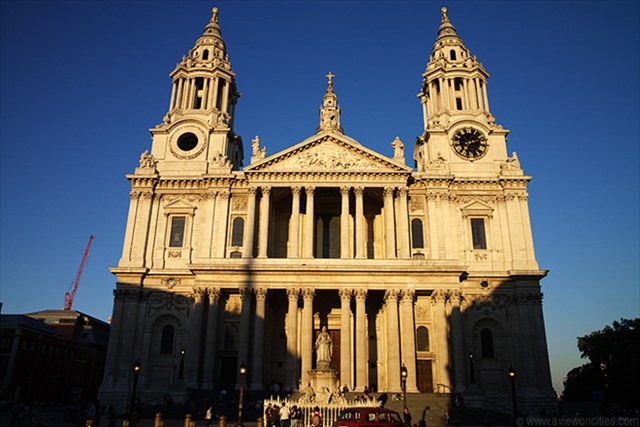St Paul's teeth
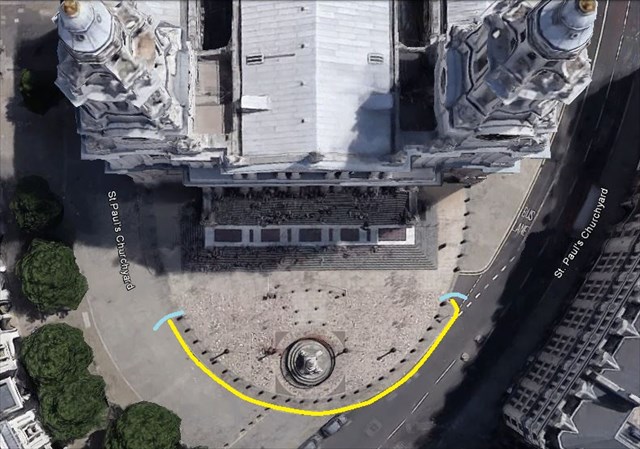
**This cache is located within an area frequently patrolled by Police. Please avoid acting suspiciously whilst searching for it, and if challenged, explain about geocaching. It may be worth pointing out that it is not a physical box you are looking for.**
The majestic St. Paul's Cathedral was built by Christopher Wren between 1675 and 1711. It is one of Europe's largest cathedrals and its dome is only exceeded in size by that of the St. Peter's Basilica in Rome.
St. Paul's Cathedral has had an eventful history. Five different churches were built at this site. The first church, dedicated to the apostle Paul, dates back to 604 AD, when King Ethelbert of Kent built a wooden church on the summit of one of London's hills for Mellitus, Bishop of the East Saxons. At the end of the seventh century, the church was built in stone by Erkenwald, Bishop of London.
In 962 and again in 1087, the cathedral was destroyed by fire, but each time it was rebuilt and expanded. By that time, it had become one of the largest cathedrals in Europe. Renovations and extensions in the thirteenth and fourteenth centuries enlarged the cathedral even more.
(More information further down. BUT first the earth lesson.)

Igneous rock
Igneous rocks are formed by the solidification of magma, a silicate liquid generated by partial melting of the upper mantle or the lower crust. Different environments of formation, and the cooling rates associated with these, create very different textures and define the two major groupings within igneous rocks:
VOLCANIC:

Volcanic rocks form when magma rises to the surface and erupts, either as lava or pyroclastic material. The rate of cooling of the magma is rapid, and crystal growth is inhibited. Volcanic rocks are characteristically fine-grained. Volcanic rocks often exhibit structures caused by their eruption, e.g. flow banding (formed by shearing of the lava as it flows), and vesicles (open cavities that represent escaped gasses).
PLUTONIC:

Plutonic rocks form when magma cools within the Earth's crust. The rate of cooling of the magma is slow, allowing large crystals to grow. Plutonic rocks are characteristically coarse-grained.
Porphyry Formation
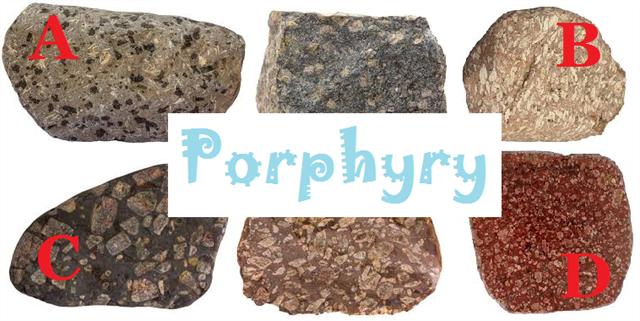
The term 'porphyry' describes a specific texture found in igneous rocks, where they contain larger crystals of certain minerals (especially feldspar or quartz), these being surrounded by a composite of minerals that have a much smaller sized crystal. The larger crystals are called 'phenocrysts' or 'sprinkle grains'. Porphyritic structures are characteristic of lavas and the igneous rocks found in dykes and sills. The phenocrysts are separated by the slower cooling of magma at depth, while the smaller-sized matrix is caused by a more rapid cooling after the magma is squeezed into a crack in the Earth's crust and/or it has reached the Earth's surface.
Porphyry deposits are formed when a column of rising magma is cooled in two stages. In the first, the magma is cooled slowly deep in the crust, creating the large crystal grains with a diameter of 2 mm or more. In the second and final stage, the magma is cooled rapidly at relatively shallow depth or as it erupts from a volcano, creating small grains that are usually invisible to the unaided eye.
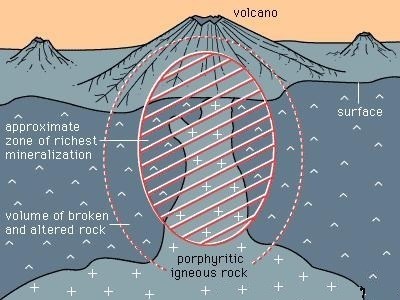
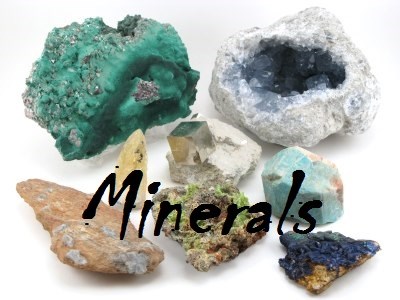
Minerals, naturally occurring elements and chemical compounds having characteristic physical properties such, crystal shape, color, line color, gloss, hardness, cleavage, fracture, density and optical conditions.
At GZ you will in this stone find especially the minerals feldspar or quartz.
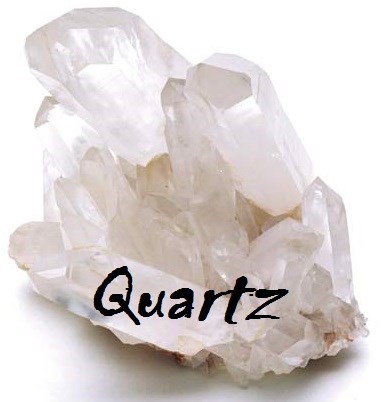
Quartz is a complex silicate in which all the oxygen atoms of the SiO4 tetrahedra are shared between two tetrahedra, leading to complex 3-dimensional frameworks. For this reason, quartz is referred to as a framework silicate.
Quartz is among the most common of all rock forming minerals and is found in many metamorphic rocks, sedimentary rocks, and those igneous rocks that are high in silica content such as granites and rhyolites. It is a common vein mineral and is often associated with mineral deposits.
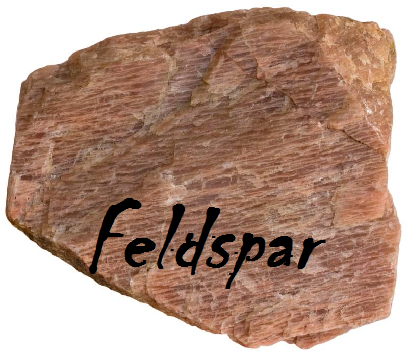
Plagioclase is a member of the feldspar group (like orthoclase) and is a framework silicate. Plagioclase consists of a solid solution between the albite and anorthite end-members, and together with quartz is the most common of the rock forming minerals.
Orthoclase is a member of the feldspar group (like plagioclase) and is a framework silicate. Orthoclase, also known as alkali feldspar or K-feldspar, is one end-member of a solid solution between orthoclase and albite.
Orthoclase is found in silica-rich igneous rocks such as granite, and in high grade metamorphic rocks.
To log this cache.
To get to log this cache you will have to read the cache text and visit the coordinates given. After that you will have to answer the questions which are related to the text and the coordinates given.
When answers are collected, send them to CO for verification. I will accept answers sent via email or through the Message Centre.
You can log immediately after answers are sent the CO. If there are any questions about your answers CO will contact you.
Logs without answers to CO or with pending questions from CO will be deleted without any further notice.
Please do not include pictures in your log that may answer the questions.
Questions
1. Answer the questions under by visiting the Coordinates.
(All the teeth here near gz can be used, so no worry for what one you pick! See the yellow smile in the picture at the top)
A.Using the terms in the cache page to help you, describe the texture you see in the 'teeth'.
B. What mineral is it that makes up what you have answered in question A?
C.Has this stone cooled in one stage or more than one? Please explain how you reached your conclusions.
D.Take a closer look at the stone(s) (teeth) here at GZ - from the PORHYRY header photo further up in the cache page, which of the four labelled examples do you see here - is it A, B, C, or D?
2. It’s voluntary to post a photo in your online log. Without revealing any answers!
St. Paul's Cathedral
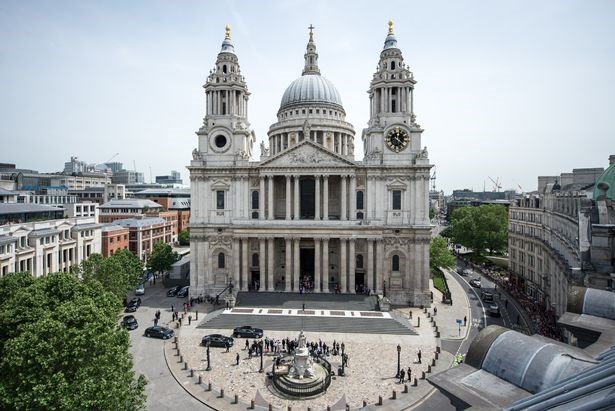
History
St. Paul's Cathedral has had an eventful history. Five different churches were built at this site. The first church, dedicated to the apostle Paul, dates back to 604 AD, when King Ethelbert of Kent built a wooden church on the summit of one of London's hills for Mellitus, Bishop of the East Saxons. At the end of the seventh century, the church was built in stone by Erkenwald, Bishop of London.
In 962 and again in 1087, the cathedral was destroyed by fire, but each time it was rebuilt and expanded. By that time, it had become one of the largest cathedrals in Europe. Renovations and extensions in the thirteenth and fourteenth centuries enlarged the cathedral even more.
The Great Fire
In 1665 Christopher Wren designed a plan for the renovation of the St. Paul's Cathedral, which was starting to fall into decay. But disaster struck again on the night of September 2, 1666, when the Great Fire of London destroyed four fifth of all of London, wiping 13,200 houses and 89 churches, including the St. Paul's Cathedral off the map.
Christopher Wren's Masterpiece
In 1669, three years after the fire, Christopher Wren was appointed 'Surveyor of Works' and was tasked with the construction of a new church to replace the destroyed Gothic cathedral.
His first design was deemed too modest. In his second design, known as the 'Great Model', the cathedral was shaped like a Greek cross, with a portico, Corinthian columns and a striking large dome, which would be the world's largest after Michelangelo's dome at the St. Peter's Basilica in Rome. This design was rejected as well; the Bishop considered it unsuitable for large processions.
Wren suggested a third design, this time with a larger nave and smaller dome, which was accepted in 1675. After the approval however Wren enlarged the dome and made several other adjustments so that the built cathedral now resembles the 'Great Model' and not the approved design.
The cathedral was built in a relative short time span: its first stone was laid on June 21, 1675 and the building was completed in 1711.
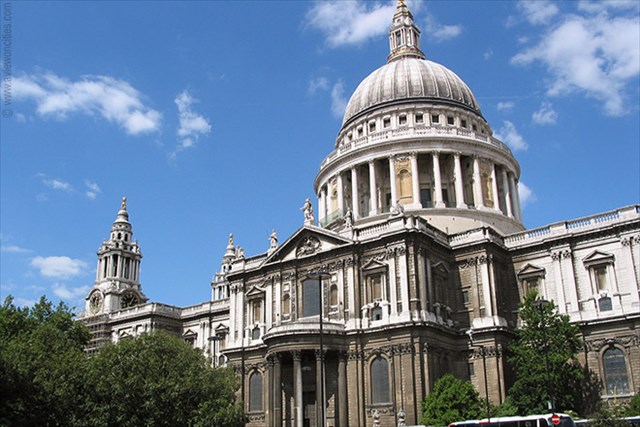
The Church
The Dome
The dome reaches a height of 111 meters (366 ft) and weighs about 66,000 tons. Eight arches support the dome. On top of the dome is a large lantern with a weight of 850 tons.
560 steps lead visitors along three galleries all the way to the top of the dome. The first gallery, the Whispering Gallery, just inside the dome, is renowned for its acoustics. The second gallery, the Stone Gallery, is situated at a height of 53 meters (174 ft) on the outside of the dome, right above the colonnade. On top of the dome, at a height of 85 meters (279 ft), is the narrow Golden Gallery, which encircles the lantern's base. From here you have a magnificent view over the City.
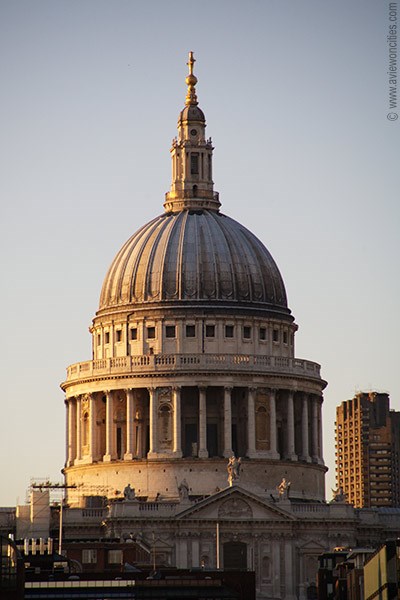
Interior
The Baroque interior is just as imposing as the exterior of the church. The mosaics on the ceiling were added in 1890 by William Richmond after Queen Victoria complained that there was not enough color in the cathedral. The baldachin above the altar was rebuilt in 1958 after it was damaged by bombardments during World War II. The design is based on a sketch created by Wren. The only monument in the church that survived the fire of 1666 is the tomb of John Donne, from 1631.
Several famous people are entombed in the cathedral's crypt. Most notable are the tomb of the Duke of Wellington - who defeated Napoleon at Waterloo - and the tomb of Admiral Nelson, who died at the Battle of Trafalgar. There is also a tomb of Christopher Wren himself and a number of important artists are buried here as well.
The West Facade
The impressive facade at the west side of the church consists of a large portico and pediment. A relief on the tympanum depicts the conversion of Paul and was created in 1706. The portico is flanked by two towers which weren't part of the original plan. Wren added them at the last minute, in 1707.
